The Strand
of the late 19th century, with its dapper merchants and brick
buildings and foreign travelers, was assuredly able to produce no less than a
picturesque tableau at any given moment of its existence. Although today these
visions are mostly relegated to the imagination, the catalogue of rampant
activity happening all at the same time, on the same street, is sufficient
enough to easily conjure a kaleidoscope of quintessential historic scenes.
The “Wall Street of the South” had always
been a street of bankers and wholesalers, commission and auction houses, but
growth begets growth in any form. Along with the readily available wealth of Galveston residents, the city was flourishing also as a
port of immigration—by the end of the 19th century it would even
surpass Ellis Island with the number of immigrants for whom the Island served as a gateway to opportunity.
Thus against this backdrop of commerce and
immigration was a thriving dry goods market. Carriage and furniture makers,
agricultural warehouses, printers and painters, grocery and liquor dealers,
candy and coffee makers lined the Strand, as
well as eight newspapers, agents that helped travelers secure passage via steam
and sail ships, and a French outlet named Pellegrini and Company that sold
ready-made clothing as well as other luxuries like artificial flowers and
perfume.
The Strand
at this time was also no stranger to the curious, with street entertainers such
as a man who would eat glass, and apothecaries peddling their mysterious
potions. Even the fabulously dressed Oscar Wilde made an appearance in 1882,
inspiring awe in onlookers as he strode toward the location where he was to
make a speech on “Decorative Art.”
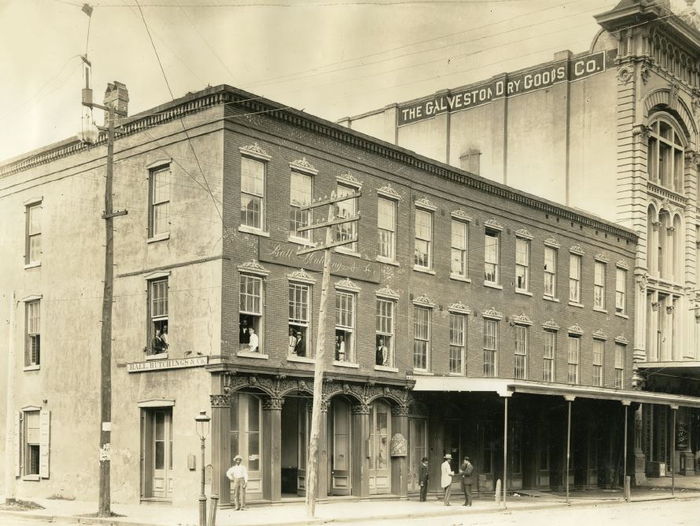 The Parade of Butchers was a New Year’s Day
custom that by all accounts originated in Galveston
in Civil War days, and it continued throughout the 1880s. Local butchers donned
masks and outlandish costumes and rode haggard horses and mules down the
street, making stops at all the taverns along the way. This decade also saw the
initiation of annual Mardi Gras parades that careened down the Strand with
pageantry and spectacle, displaying Galveston’s
elite atop fanciful floats and filling downtown with the raucous revelry of
brass bands.
The Parade of Butchers was a New Year’s Day
custom that by all accounts originated in Galveston
in Civil War days, and it continued throughout the 1880s. Local butchers donned
masks and outlandish costumes and rode haggard horses and mules down the
street, making stops at all the taverns along the way. This decade also saw the
initiation of annual Mardi Gras parades that careened down the Strand with
pageantry and spectacle, displaying Galveston’s
elite atop fanciful floats and filling downtown with the raucous revelry of
brass bands.
Additionally, the international trade brought
sailors and seamen of all nationalities and ethnicities to the humble coastal
town, creating a demand for exotic cuisines and foreign niceties that were all
but lost to towns of the interior. This melting pot mentality also manifested
itself prominently in the architecture of the Strand,
the designs of which were influenced by architectural genres from all over the
world. Galveston’s
haven of commercial activity attracted all sorts of genius from every
profession looking to invest their talents for fortune, not the least of whom
were up-and-coming architects, walking by the empty lots that would one day
make them immortal.
With a population of twenty-two thousand in
1880, Galveston was the largest city in the
state of Texas.
It was a modern and cosmopolitan city, prosperous and beautiful, sophisticated
and grand. In 1881 alone, over thirty-eight million dollars worth of
merchandise exchanged hands on the Strand.
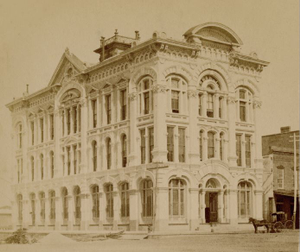 That same year, Nicholas J. Clayton, who had
emerged on the Strand as the first full-time architect in Galveston with his
construction of the Gulf, Colorado, & Santa Fe Railroad Building on the
corner of 25th Street, stunned the Strand yet again with one of his
most detailed works, the Greenleve-Block building (2314-2318 Strand) for
Greenleve, Block, and Company, one of three of the largest wholesale dry goods
firms in town. The monstrous, four-story building boasted an intricate cornice
that ran the entirety of the roofline, giving an appearance of a fifth floor.
Three large bays opened onto the street, the entrances embellished with
detailed carvings etched into the stone that depicted the Texas star, the letter “G” for Greenleve,
and street numbers. Upon its completion, the genius of Nicholas Clayton was
considered unrivaled and he was soon sought-after by the wealthiest men in
town.
That same year, Nicholas J. Clayton, who had
emerged on the Strand as the first full-time architect in Galveston with his
construction of the Gulf, Colorado, & Santa Fe Railroad Building on the
corner of 25th Street, stunned the Strand yet again with one of his
most detailed works, the Greenleve-Block building (2314-2318 Strand) for
Greenleve, Block, and Company, one of three of the largest wholesale dry goods
firms in town. The monstrous, four-story building boasted an intricate cornice
that ran the entirety of the roofline, giving an appearance of a fifth floor.
Three large bays opened onto the street, the entrances embellished with
detailed carvings etched into the stone that depicted the Texas star, the letter “G” for Greenleve,
and street numbers. Upon its completion, the genius of Nicholas Clayton was
considered unrivaled and he was soon sought-after by the wealthiest men in
town.
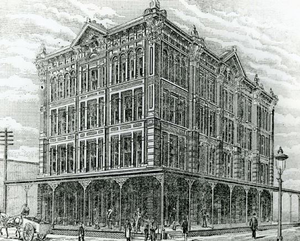 Clayton was next hired by Colonel W.L. Moody
in 1883 to rebuild his fire-ravaged property on the northwest corner of Strand and 22nd. Although similar in form to
the Greenleve Block building, with four stories, an elaborate cornice, and a
showy cast-iron façade, Moody’s building was entirely unique and attributable
to Clayton only by its grandness and attention to detail. Inlaid panels of multi-colored
tiles established depth in the façade and highlighted the large windows, and
the involved brickwork and terra cotta finish gave the final result Clayton’s
trademark texture.
Clayton was next hired by Colonel W.L. Moody
in 1883 to rebuild his fire-ravaged property on the northwest corner of Strand and 22nd. Although similar in form to
the Greenleve Block building, with four stories, an elaborate cornice, and a
showy cast-iron façade, Moody’s building was entirely unique and attributable
to Clayton only by its grandness and attention to detail. Inlaid panels of multi-colored
tiles established depth in the façade and highlighted the large windows, and
the involved brickwork and terra cotta finish gave the final result Clayton’s
trademark texture.
Meanwhile, the Mallory Produce building just
west of 21st Street
had burned again in 1881, but fortunately this time it was able to be repaired
instead of entirely rebuilt. Shortly after the repairs were complete,
construction on the Mensing Brothers and Company Building (2118-2128) next door
to the west was begun in 1882. Although only two stories, the corner building
featured rounded archways across the two sides of its street-level arcade and
the brick was stuccoed for a smooth stone finish. Inside, the building housed
one of the largest cotton factors and grocers, with a large part of the second
floor dedicated as the cotton sample and auction room.
But it was not until the end 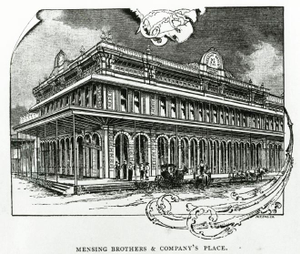 of the decade
that anyone dared rival the staggering designs of Clayton, when another noted Galveston architect named
Alfred Muller completed the City Hall building in 1888. The building faced the Strand but was placed directly in the middle of 20th Street
to allow for traffic around its perimeter. Of stunning Gothic design,
of the decade
that anyone dared rival the staggering designs of Clayton, when another noted Galveston architect named
Alfred Muller completed the City Hall building in 1888. The building faced the Strand but was placed directly in the middle of 20th Street
to allow for traffic around its perimeter. Of stunning Gothic design, 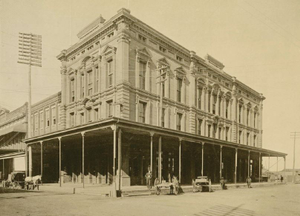 the
building was home to a marketplace on the ground level where local farmers and
fishermen would sell their goods; the second and third floors were used for
municipal activities and the offices of city officials.
the
building was home to a marketplace on the ground level where local farmers and
fishermen would sell their goods; the second and third floors were used for
municipal activities and the offices of city officials.
By the 1890s the Strand was nearly saturated
save for a gaping hole at the end of 25th Street where the Gulf,
Colorado, and Santa Fe Railroad building had previously stood before it was
destroyed by fire in 1891. But the ensuing decade would fill in the last
remaining gaps and officially complete the notable architectural alley that
remains today. In 1890 the private banking firm of Adoue & Loubit sought
again the mastermind of Nicholas Clayton for their building on the northwest
corner of 21st Street. He managed to reign in his artistry and opt
for a modestly involved design for the building—perhaps so that it purposely
did not reveal that its residents were one of the largest financial operations
in the city at the time.
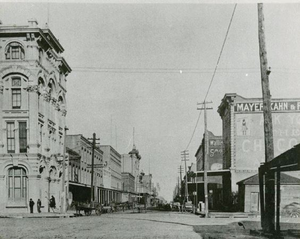 Across the street and a block to the east,
the John D. Rogers Building (2013-2019) between 20th and 21st
brought closure to that particular block in 1894. Historians assume that
although Rogers left an indelible mark on the building by way of having his
initials emblazoned on the east cornice, he most likely built the simple, stoic
building as an investment property. It was immediately occupied by an importing
company despite the fact that Rogers was a successful cotton merchant and owned
a large manufacturing company.
Across the street and a block to the east,
the John D. Rogers Building (2013-2019) between 20th and 21st
brought closure to that particular block in 1894. Historians assume that
although Rogers left an indelible mark on the building by way of having his
initials emblazoned on the east cornice, he most likely built the simple, stoic
building as an investment property. It was immediately occupied by an importing
company despite the fact that Rogers was a successful cotton merchant and owned
a large manufacturing company.
In 1895, just when Galveston thought they had
seen the best of Nicholas J. Clayton, he wowed yet again with his neo-Renaissance
rebuild of the Hutchings & Sealy bank on the northeast corner of 24th
Street. Utilizing a rare yellow brick and impressive granite, palatial columns
rose the entire height of its three stories. Numbers carved into the 24th
Street side represent the year the firm moved to Galveston, 1854, as well as
the year of the building’s construction.
On the Strand side, the names “Hutchings” and
“Sealy” over two distinct entrances reveal that the building is actually two
separate properties built as one, with a large atrium between them that reaches
skyward—it provided both air flow and natural light to the expanse of the
building.
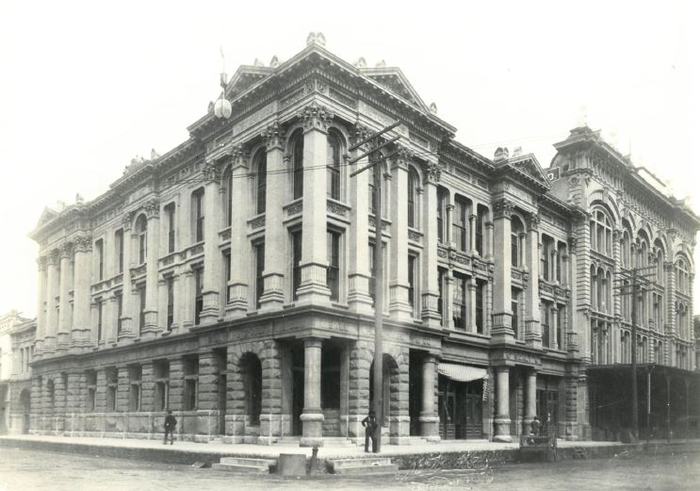 Finally in 1898, the James Fadden Building
(2410-2412) would become not only the last building of this era ever erected,
but also the last notable work of Nicholas Clayton, whose fame and financial
situation would plummet shortly thereafter although he did continue to work
until his death in 1916. It was a much scaled-down version of his other, more
monumental designs, but Clayton still managed to make the building unmistakably
his with Roman columns, ornamental brickwork, and a
cornice that disguises the false-front of a nonexistent third floor.
Finally in 1898, the James Fadden Building
(2410-2412) would become not only the last building of this era ever erected,
but also the last notable work of Nicholas Clayton, whose fame and financial
situation would plummet shortly thereafter although he did continue to work
until his death in 1916. It was a much scaled-down version of his other, more
monumental designs, but Clayton still managed to make the building unmistakably
his with Roman columns, ornamental brickwork, and a
cornice that disguises the false-front of a nonexistent third floor.
Most certainly, the last two decades of the
19th Century were ones of a feeling of invincibility for the Strand
and the city. As the new century approached, the population more than doubled
to nearly forty-five thousand yet even still Galveston claimed the per capita
rating of the second wealthiest city in the nation, second only to Newport,
Rhode Island—the home of the Vanderbilt’s. It was a city of potential with a
street of plenty. The only thing that could stop Galveston’s meteoric rise was
the one thing that no one ever saw coming.
Chapter 1 - 2 - 3 - 4 - 5 - 6 - 7- 8 - 9 - 10 -11 - 12